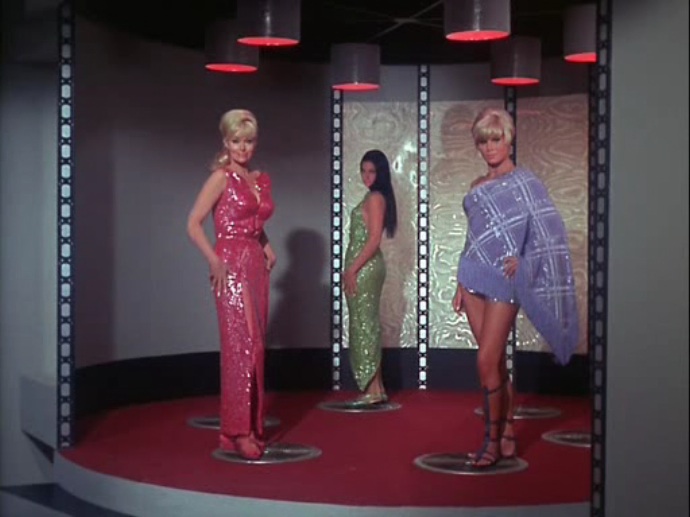1. Introduction: What is a vid?
[1.1] Vidding is a form of grassroots filmmaking in which clips from television shows and movies are set to music. The result is called a vid or a songvid. Unlike professional MTV-style music videos, in which footage is created to promote and popularize a piece of music, fannish vidders use music in order to comment on or analyze a set of preexisting visuals, to stage a reading, or occasionally to use the footage to tell new stories. In vidding, the fans are fans of the visual source, and music is used as an interpretive lens to help the viewer to see the source text differently. A vid is a visual essay that stages an argument, and thus it is more akin to arts criticism than to traditional music video. As Margie, a vidder, explained: "The thing I've never been able to explain to anyone not in [media] fandom (or to fans with absolutely no exposure to vids) is that where pro music videos are visuals that illustrate the music, songvids are music that tells the story of the visuals. They don't get that it's actually a completely different emphasis" (personal communication, October 24, 2006).
[1.2] Jake Coyle (note 1) makes this mistake in a recent news article, "The Best Fan-Made Music Videos on YouTube," in which he surveys the many "startling, worthy videos" made by fans, the best of which "make use of film in public domain or lifted from copyrighted material." Coyle's article, which was distributed by the Associated Press and widely linked across the Internet, begins, "Since the dawn of YouTube, fans have been melding their own amateur video with the music of their favorite bands." Coyle's underlying—and unquestioned—assumption is that the fans who make "fan-made music video" are fans of the audio source, that these fans edit footage to music because they like the bands. In this kind of music video, the visuals serve the music; Coyle describes these videos as music "revisualized online."
[1.3] But the assumption that music videos are intended to illustrate music leads Coyle to misunderstand the only songvid he discusses, and perhaps not coincidentally, the only "startling, worthy" video on his list made by women: T. Jonesy and Killa's "Closer" (http://blip.tv/file/2289542; 2003). Coyle describes "Closer" as "footage from 'Star Trek,' scratched and colored to roughly match the style of the original video"—that is, director Mark Romanek's notorious music video for Nine Inch Nails. Coyle grapples with "Closer," which he finds "weirder" than the other music videos he discusses, possibly because its footage is so evidently not engaged in the project of "revisualizing" its music. Coyle then suggests that T. Jonesy and Killa are using Star Trek to reimagine Mark Romanek's original video for the song, except that "Closer" doesn't have much to say about Romanek's footage. What "Closer" does have to say, it says about the character of Mr. Spock; in other words, both the Nine Inch Nails song and Romanek's video are used to provide new meaning to the source footage. Coyle ultimately admits this, noting that, "The song (which includes explicit lyrics) makes Spock look terrifying," but he doesn't seem to realize that this marks a shift from music criticism to media criticism.
[1.4] Vids like "Closer" come from a tradition of vid making significantly older than "the dawn of YouTube." In 2005, the year that YouTube was founded, media fans celebrated the 30th anniversary of vidding at Vividcon, an ongoing convention dedicated to vids. For those fans, the art of vidding begins with Star Trek and Spock. The Vividcon community traces its lineage back to Kandy Fong's Star Trek slide show, "What Do You Do With a Drunken Vulcan?" (1975). At the same time, much has changed between that first slide show and today's vids. Vidding has expanded far beyond Star Trek: thousands of vids have been made analyzing popular source texts, and most television shows and movies have had at least one vid made about them. Vidding has also advanced technologically: vidders have worked with slide projectors, VCRs, and computers; they have used film stills, VHS tape, and DVD source footage; they have shown their work at conventions and distributed it through the mail and over the Internet in both downloadable and streaming forms. A computer-generated, rapidly cut, effects-laden vid made in 2008 and distributed on YouTube or Imeem might seem a far cry from the slide shows and early VCR vids that vidders claim as antecedents, but these works share an aesthetic tradition and an analytical impulse not immediately obvious to the outsider.
[1.5] It is therefore important, in this time of rapidly growing interest in DIY video, to document the history of this decades-old artistic tradition, especially as most popular media commentators fail to realize that most of the video hosted on YouTube wasn't made for YouTube. YouTube isn't a creative force; it's a distribution mechanism, and although it and other media platforms are enabling many subcultural art forms to be visible for the first time, the coherence of vidding as a tradition might be lost in a sea of user-generated content. There is also a danger that vidding's pre-YouTube culture—invisible, underground, female-dominated—might be ignored or written out of media history, much as the history of the novel was written to exclude the lady novelists Nathaniel Hawthorne so notoriously referred to as a "damned mob of scribbling women." In this essay, I begin to write a history of vidding women, not only to demonstrate broad continuities in vidding practice over the course of changing technologies, but also specifically to connect these practices and aesthetics back to their evolution out of Star Trek.
2. The problem of Star Trek: From Number One to first lady
[2.1] To trace the history of fannish vidding is to trace the emergence of a distinctively female visual aesthetic and critical approach. It is worth noting that 1975, the year that Kandy Fong made her first Star Trek slide shows, was also the year of Laura Mulvey's essay "Visual Pleasure and Narrative Cinema" in Screen (1975). Second-wave feminism had popularized ideas of female independence and sexual subjectivity, priming woman to take control of the camera, and many vids reverse, or at least complicate, traditional scopophilia of the kind Mulvey describes, casting men as objects of visual desire and addressing sexist problems in visual texts.
[2.2] Vidders locate the origin of this distinctive female filmmaking practice within Star Trek fandom. But why Star Trek? Thirty-five years after the first Star Trek conventions, 25 years after the first ethnographies of Star Trek fan culture, it has become commonplace to locate a whole range of artistic practices in Star Trek without theorizing why it should be so. But making art is not just something Trekkies do, though science fiction and media fans are often discussed as if they were a race or a biological type. Rather, I would argue that vidding developed in response to Star Trek (and the figure of Spock in particular) for some very specific reasons.
[2.3] First, and most simply, the women who were fans of science fiction in general and Star Trek in particular had among them a high proportion of scientists, computer programmers, and mathematicians. As Melissa Dickinson (2006) notes, many Star Trek BNFs (big name fans) had advanced degrees in science and engineering: Jacqueline Lichtenberg (Star Trek Lives!) was a chemist; Judy Segal (head of the Star Trek Welcommittee) has a master's degree in botany; Joan Marie Verba (Boldly Writing: A Trekker Fan and Zine History, 1967–1987) has a bachelor's degree in physics, went to graduate school for astronomy, and worked as a computer programmer before becoming an editor and writer. Similarly, Mary Van Deusen, a vidder who was responsible for teaching scores of others to vid, has an undergraduate degree in physics, graduate degrees in mathematics and computer science, and a long career working for the research division of IBM. Other early vidders had similar scientific expertise, interests, or careers. These women were not afraid of technology: they knew how to program a VCR.
[2.4] But second—and this answer is related to the first—Star Trek contains within it a problem that many vids have attempted, literally or metaphorically, to solve: at the center of the text is a displaced woman. The original, failed Star Trek pilot "The Cage" (1964), written by Gene Roddenberry and featuring Jeffrey Hunter as Captain Christopher Pike, also introduced the captain's aloof, unemotional, and tactically brilliant second in command. This was not the famously logical Spock; rather, her name—fitting for such a mechanical woman—was "Number One." Although Spock was in the pilot, he was not the cool, highly rational Spock we know now. In fact, Star Trek's insistence on the Enterprise's first officer as an unemotional mind makes particular sense if the character is a woman: it is a 1960s picture of an unnatural—for which read: strong, highly rational, technologically minded—woman.
[2.5] As first officer, Number One fulfills the same role for Pike as Spock later does for Kirk. Not only is she the officer the captain relies on most, but she's also marked by her difference; in fact, as with Spock, there's a suggestion that her worth is part and parcel of her difference. In an early scene, Pike dismisses a female yeoman and then mutters to Number One, "I just can't get used to having a woman on the bridge." When Number One does an understandable double take, Pike quickly backpedals. "No offense, Lieutenant," he says. "You're different, of course" (figure 1).
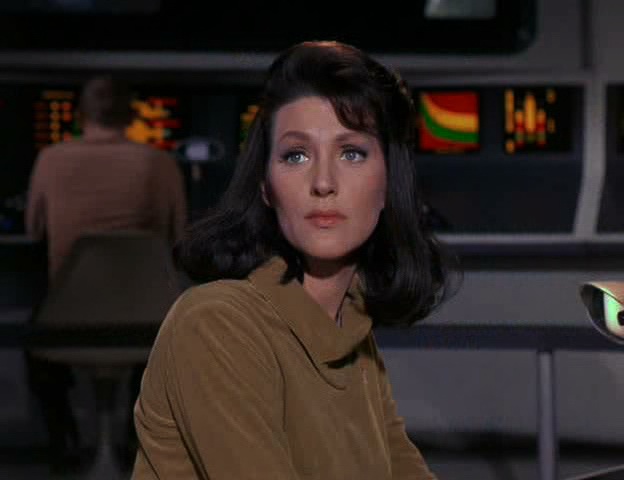
Figure 1. Number One's double take in Star Trek's original pilot, "The Cage" (1964).
[2.6] As Majel Barrett plays it, Number's One's reaction to this declaration of difference is yet another double take, followed by a controlled flash of anger and then hurt; she is visibly not pleased that Captain Pike doesn't see her as a woman.
Clip 1. Clip from Star Trek's original pilot, "The Cage" (1964), showing Number One's reaction to a remark of Captain Pike's.
[2.7] This theme is expounded upon throughout the rest of the episode, during which aliens kidnap Pike to press him into fathering a new human race. In service of this goal, the aliens offer him a variety of potential mates, including Number One, Yeoman Colt, and Vina, the sole survivor of a crashed scientific expedition. Vina is desperate to seduce Pike into being Adam to her Eve and furious at the arrival of female competition. Sizing up the statuesque (and sensibly dressed) Number One, Vina snorts, "They'd have more luck crossing him with a computer." Despite this insult to her womanhood and her humanity, Number One keeps her composure: "Well, shall we do a little time computation? There was a Vina listed on that expedition as an adult crewman. Now, adding 18 years to your age then—"
Clip 2. Clip from Star Trek's original pilot, "The Cage" (1964), with Number One being compared to a computer.
[2.8] Although the overly scientific syntax of "time computation" foreshadows Spock's irritating levels of precision, the fact that this is mathematics in the service of cattiness shows Roddenberry struggling to imagine that unimaginable creature of science fiction: a highly rational woman in a position of power. Forget Spock: Number One is Star Trek's truly divided soul, the show's real half-human, half-alien being.
[2.9] "The Cage" reveals Roddenberry's interest in women as both sexual subjects and objects. When Star Trek fans talk about "The Cage," it's often to note how surprisingly emotional Spock is; when Number One and Yeoman Colt are kidnapped, it is Spock who cries out, overcome with emotion, "The women!" But although this is probably the episode's most famous clip, it's easy to ignore how genuinely "The Cage" is about the women. At the episode's climax, when all the characters are brought together in the eponymous cage, the frame literally teems with women—more than we ever see again (figure 2).

Figure 2. Women in the climax of Star Trek's original pilot, "The Cage" (1964).
[2.10] From left to right (and in diminishing order of size), we have Number One, Yeoman Colt, and a dejected Vina. Even the alien with the giant head is female (male voices were overdubbed onto the bodies of made-up actresses). It is worth taking a moment to note the presence of four women together on a television screen, even if three of them (blonde, redhead, and brunette) are there to offer sexual variety to Captain Pike. The glass cage itself evokes a peepshow or striptease, rather than the zoo implied by the episode's title. But Pike is also behind glass and served up for our gaze—picked out, in fact, by his gold tunic while the women around him are dressed in shades of gray. Still, the women of "The Cage" are noticeably individual. Only one of them—Vina—is presented to us as a traditionally "seductive" woman of the kind later typical of Star Trek (note 2); the others have believably different assets and personalities.
[2.11] In fact, these assets are ruthlessly laid out for Pike (and us) by the aliens:
[2.12] The female you call Number One has the superior mind and would produce highly intelligent children. Although she seems to lack emotion, this is largely a pretense. She often has fantasies involving you…The other new arrival [Yeoman Colt] has considered you unreachable, but now is realizing this has changed. The factors in her favor are youth and strength, plus unusually strong female drives.
[2.13] This gloss of Number One's character—"highly intelligent," "seems to lack emotion"—marks her as the original of Spock. Moreover, the aliens tell us two things about Number One that many female fans also believe to be true of Spock, and perhaps more crucially of themselves: that her lack of emotion is largely a pretense, and that behind her controlled, professional demeanor lies a sexually desiring subject.
[2.14] "She often has fantasies involving you": in this, we can see not only the explanation for much Kirk/Spock slash (to the extent to which we believe that Spock, like Number One, secretly desires his captain) but also the origin of much of the imaginative fan fiction, fan art, and vids created by female engineers, physicists, and computer programmers. Among the stories "The Cage" tells is that of a desiring female subjectivity that—surprisingly—can coexist in the same body as strength, rationality, and the ability to add numbers. But this character, and the internal struggle she embodied on screen in the middle of the second-wave feminist movement, were eliminated from the second iteration of Star Trek (note 3), although actress Majel Barrett was not. Not only was she recast, but Roddenberry chose her for his mate. Reader, she married him! Thus did Number One become "the first lady of Star Trek."
[2.15] Mr. Spock is a ghost, the shadow of a missing woman. This visual substitution of the alien man for the rational woman is at the heart of much of the art produced in response to Star Trek, though it is among the least-discussed aspects of the show. Mr. Spock has been read in many ways—as Jewish, Asian, black, demonic, countercultural, even as Asperger's sufferer (note 4)—but the original Spock shape in the Star Trek canon is female. Spock is a kind of visual marker, a scar indicating a series of conflicts meaningful to the scientifically minded, technologically oriented women likely to become vidders, especially in the early years of vidding.
[2.16] While Number One haunts Star Trek through the overdetermined figure of Spock, Majel Barrett Roddenberry was recast in two roles that exemplify the problematic way that women are typically represented in popular culture: Nurse Christine Chapel, whose primary characterological gestus is her embarrassing and hopeless public crush on Spock, and the disembodied voice of the Enterprise. It is hard not to see Barrett's transformation from Number One to Christine Chapel as a degradation on every level: role, status, and image.
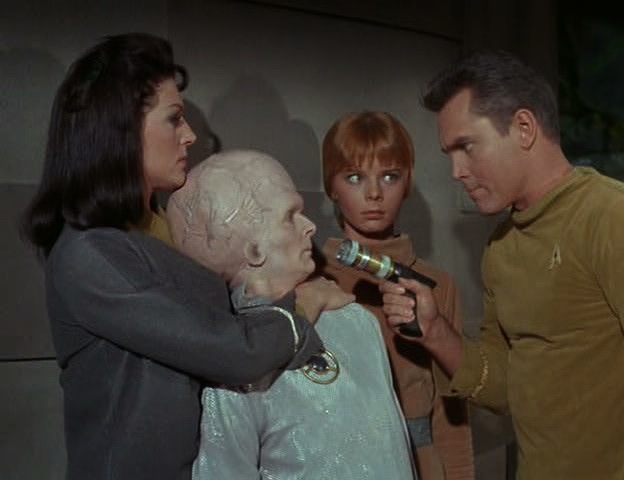
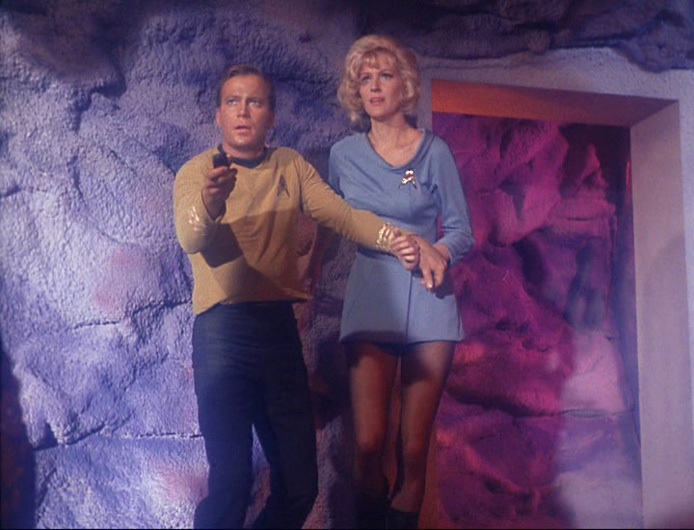
Figures 3 and 4. Number One, the captain's equal, subduing an alien, in an image from Star Trek's original pilot, "The Cage" (1964), turns into the vulnerable Nurse Chapel.
[2.17] In the above scene from "The Cage" (figure 3), Pike throws the captured alien toward Number One, who puts him into a headlock. She is framed as Pike's ally and partner: they're literally of the same height, and together they bracket the frame powerfully. Compare this to the image of Captain Kirk and ship's nurse Christine Chapel (figure 4). Here, burdened with a miniskirt, go-go boots, and a blowsy blonde hairdo, Barrett plays the damsel in distress, cowering behind Shatner's protective arm despite her obvious height and strength. Worse yet is her relationship to Spock, which Kathy E. Ferguson, Gilad Ashkenazi, and Wendy Schultz have characterized as "emotionally subordinate" (1997:216): arguably, she exists merely to pine.
[2.18] Barrett also plays the disembodied voice of the Enterprise. Scholars have already noted the camera's love of the Enterprise and the way that its gaze feminizes the ship. Daniel Bernardi writes persuasively about how the depiction of the Enterprise in the first Star Trek movie (1979) is similar to the representation of women in film as theorized by Mulvey: "Like the representations of women in Hollywood cinema, the Enterprise is a feminized figure eliciting scopic desire. The starship is literally a show-stopper, temporarily halting the progress of the story. 'She' is fragmented into parts by both the composition of the close-up shots and the design of the scaffolding" (Bernardi 1998:72) (note 5). As played by Barrett, the ship speaks in a human voice but has no human body; the voice of female authority has been detached from embodied, messy female physicality. To revisit Vina's remark in "The Cage" ("They'd have more luck crossing him with a computer"): the metaphor of the scientific, rational woman as machine has become literalized. Majel Barrett's (modified, metallic) voice is the voice of the all-knowing and powerful computer that controls the Enterprise.
[2.19] In these two guises—Nurse Chapel and the Enterprise computer—the displaced character of Number One serves as the model for two archetypical fan positions: the woman who embodies visible desire, and the disembodied but all-controlling voice. The former is often presented as a negative fan stereotype: the groupie, the stalker, the shrieking Beatlemaniac, the "Mary Sue" who dreams herself into the story, the girl with the embarrassing public crush on a movie star. The latter, I would argue, is the voice of the vidder: the woman behind the camera, slide projector, VCR, or computer, the technological woman who controls the machine. The disembodied voice is also the voice of the slash writer (who writes about bodies not her own) or the omniscient and controlling fan artist who takes control of the protagonists' images and bends them to her will. But most fan works seek to unite the analytical mind and the desiring body in order to create a total female subjectivity.
[2.20] Although vidding has now moved beyond Star Trek, the representational tensions at the show's heart have not gone away. Consequently, many vids still make overt or subtextual arguments about gender, and vids in a broad variety of fandoms engage issues of female representation, displacement, and marginalization in visual culture.
3. Seeing life from both sides: Kandy Fong's slide shows
[3.1] In 1975, Kandy Fong made what is arguably the first vid by constructing a slide show that set Star Trek images to music. Fong had access to footage left on Trek's cutting room floor and, inspired by the Beatles video to "Strawberry Fields Forever," built a narrative around an original filk, or fannish folk song. As Fong (personal communication, October 14, 2006) explains:
[3.2] That Sept [1974], the longest running Star Trek fan club in the world—The United Federation of Phoenix—was formed. There I met my future husband, John Fong. He had shoeboxes full of pieces of film that were left over from when the episodes were edited. He purchased them from Lincoln Enterprises run by Majel Barrett/Roddenberry. We really needed something different to show at a club meeting. There was a popular filk song 'What do you do with a Drunken Vulcan' and I suggested that we pick out pieces of film that seemed to go with the song. Several of the club members & I used a cassette to record the song. John made the film pieces into slides so we could show it at a club meeting. I would follow the words along in a script & "click" the single projector at certain words. It was very popular.
[3.3] Fong took her slideshow to the Equicon/Filmcon convention chaired by Bjo Trimble in the spring of 1975. As Fong remembers it, "This was the only 'new' Trek since the show had ended & it had people lined up. We had a small room in the lower level & kept running it over–over." The success of "What Do You Do With a Drunken Vulcan?," as well as the explicit approval of Gene Roddenberry, who was already angling to make a Star Trek movie and knew that an energized fan base helped his case, encouraged Fong to make more and show them on the science fiction convention circuit. Fong remembers, "For several years, I would travel from Seattle to San Diego to Boston to Houston showing my shows. I would show the older stuff, then make sure there where 1 or 2 new ones at each con. I ended up with several hours of shows." Eventually, Fong moved to using two slide projectors so she could cut between her slides more rapidly, essentially making her edits live, incorporating her body as part of the filmmaking process. Later still, Fong began to videotape her results, partly because Roddenberry wanted copies and partly because Fong herself became interested in creating records of fannish art. "I hated going to a con and seeing something great, but not being able to ever see it again," Fong explained, and she claims to be the first person to come up with the idea of a con tape: a videocassette documenting what was shown at a particular con. Con tapes caught on and are still made today, although they are now DVDs, often of premiering vids.
[3.4] Because Fong videotaped her work, we have some examples of these early slide shows. Like "What Do You With a Drunken Vulcan?," "Both Sides Now" (http://blip.tv/file/2288657; ca. 1980, taped 1986) is also a visual analysis of Spock. Although the song was written by Joni Mitchell and popularized by Judy Collins, Fong uses Leonard Nimoy's own 1968 version. Fong selects images that make it clear that the voice of the song is not Nimoy's but Spock's. Spock is reflecting on his own experiences, which we have shared with him through the narrative of Star Trek. Although the song is of its moment and the cutting is almost unbearably slow by contemporary standards, this early vid does two notable things: first, it creates an intertext between two of Leonard Nimoy's artworks, his acting and his singing; and second, it gives Spock a voice, and it's not the voice a casual viewer of Star Trek would expect, despite its being Nimoy's own voice.
[3.5] The first image of "Both Sides Now" (ca. 1980, taped 1986), which features a bearded Spock contemplating Captain Kirk's profile, signals one kind of doubleness: the image is from the doubly titled 1967 episode, "Mirror, Mirror," in which Kirk and some of his crew are swapped into a brutal parallel universe (figure 5).
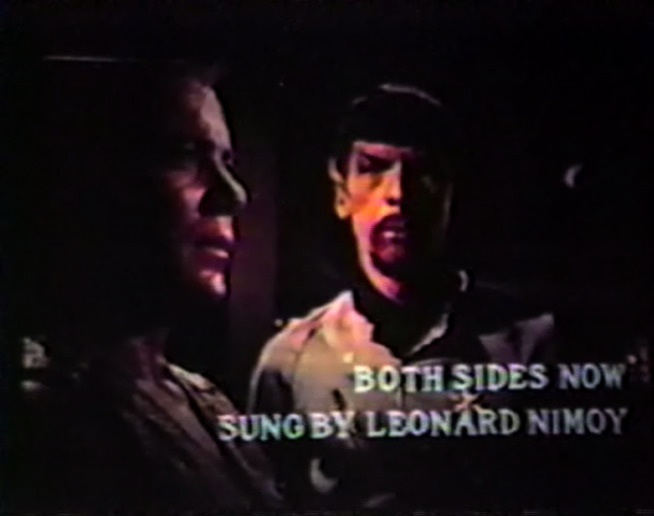
Figure 5. Opening image from Kandy Fong's fan vid "Both Sides Now" (ca. 1980, taped 1986), taken from the Star Trek episode "Mirror, Mirror" (1967).
[3.6] The bearded Spock is the doppelganger version, and the image has become a pop culture cliché: if we see a normally clean-shaven character with a goatee, we know he's the evil version. But actual doppelgangers are only the most obvious form of double vision on display. In fact, Fong uses "Both Sides Now" to comment on the more intrinsic dividedness of Spock's character: his dual nature as a half human, half alien caught between two different cultural and expressive traditions. As the only alien crew member aboard the Enterprise, Spock is frequently teased for his racial and philosophical differences in a way that would today probably qualify as workplace harassment, and we also know from his human mother that Spock was regarded as an alien "half-breed" on Vulcan as well.
[3.7] This otherness has made Spock a stand-in for many minority groups, but also, as I have argued above, a significant figure of identification for women. As a stand-in for Number One, and as the inheritor of her gendered problems as a strong, highly ranked woman in a male hierarchy, it can be argued that Spock sees "from both sides" of the gender divide. As Melissa Dickinson (2006:170) notes, "there are some clear reasons why women science fiction fans of the '60s and early '70s—many of whom held advanced science and engineering degrees—might have connected powerfully with Star Trek (and specifically with Spock) as an expression of their own alienation among peers." Consequently, the vid is fraught with gender slippage. "Both Sides Now" constructs an emotional inner voice for Star Trek's most notorious unemotional character. But the fact that it is Leonard Nimoy's voice (from a track off his album, knowingly titled The Way I Feel) adds legitimacy to the idea that this interior monologue really could be Spock's, however laughable that might seem to someone reading the text superficially. The sung lyric tells us that the narrator has looked at both sides of "clouds" (which Fong interprets more or less literally; as someone whose job involves interplanetary flight, Spock has certainly seen both sides of clouds) as well as "love." Fong uses the phrase to unpack a series of significant images, including one where Spock is framed as looking both at Christine Chapel (a textual, if thwarted, love interest) and at James Kirk (a subtextual one).
[3.8] The sung assertion, "I've looked at love from both sides now," in Spock's own voice turns the subtextual homoerotics into text (figure 6).
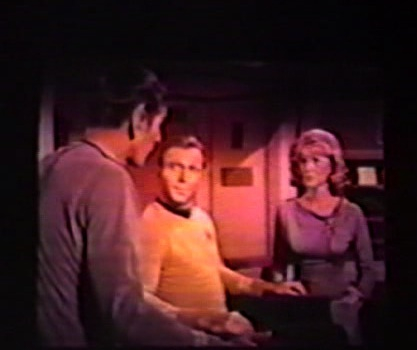
Figure 6. Image from Kandy Fong's Star Trek fan vid, "Both Sides Now" (ca. 1980, taped 1986), illustrating the lyric, "I've looked at love from both sides now."
[3.9] It also makes us look at the footage differently. In the slide Fong uses with this lyric, Spock, at the far left, is part of the frame. He stands in for us, and like us, he is doing the looking: we are asked to see the famously logical Spock as a desiring subject. Looking back at him are Kirk and Chapel, and although Kirk is sitting and Chapel is standing, they're paralleled in the frame as blonds of analogous height. Fong's editing choice further asks us to question whether Spock's dual nature as half human, half alien (or perhaps we should say, both human and alien) might also imply his bisexuality. We are explicitly asked to consider whether Spock is attracted to both men and women, to read Spock's inner landscape as well as his outer appearance. Spock is, after all, a character whose primary gestus is rigid self-control, but who would imagine that the tall, deep-voiced, and dignified actor Leonard Nimoy had that much Joni Mitchell in him? If Nimoy has this voice inside him, why not Spock?
[3.10] Each image Fong selects can and should be subjected to this sort of analysis. To the extent to which we recognize these slides and can contextualize them within our broader knowledge of Star Trek, we may find the conjunction of music and image provocative. Fong asks us to reread the images she presents through the lens of the song, sometimes just for amusement purposes—for example, the lyric "But now old friends are acting strange" appears in conjunction with an overtly humorous image of Kirk and McCoy. But Fong also asks questions and makes various sorts of textual arguments. Given the lyric "It's love's illusions I recall," how are we to interpret this image (figure 7)?
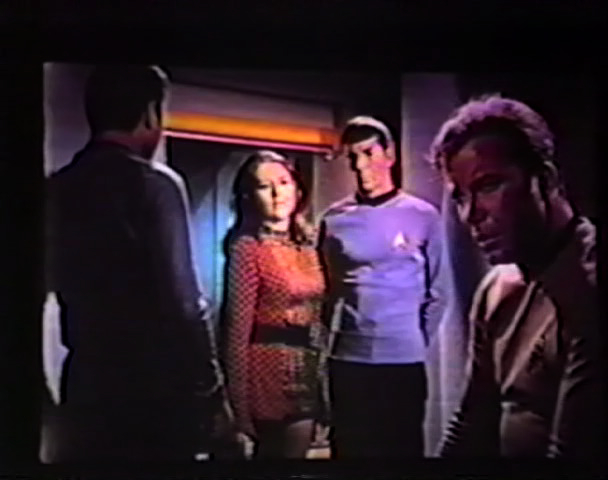
Figure 7. Image from Kandy Fong's Star Trek fan vid, "Both Sides Now" (ca. 1980, taped 1986), illustrating the lyric, "It's love's illusions I recall."
[3.11] The episode "The Enterprise Incident" (1968) has Kirk and Spock conspiring to steal a cloaking device from under the nose of a female Romulan commander (in red in figure 7). As part of the plan, Kirk feigns mental illness, fakes his own death, and has plastic surgery so he can go undercover as a Romulan. Spock, meanwhile, subtly romances the Romulan commander, who seems genuinely attracted to him and who offers him a post as her second in command, promising him that she, unlike the humans he currently works with, actually understands and appreciates him. So when Spock recalls "love's illusions," does he mean Kirk's trickery? His own? The Romulan commander's offer of love and respect, which he must turn down?
[3.12] This interpretive quality makes Fong's slide show a vid and marks her as the founder of the form. "Both Sides Now" is a visual essay in which music is used as an analytical tool and not a soundtrack. By using image and sound to stage the contrast between Nimoy's external appearance and inner voice, Fong teases out various kinds of "bothness" surrounding the text: human and alien, male and female, heterosexual and homosexual, reason and emotion, control and desire. She has excavated the complexities of Spock's character, highlighting some of the key traits that have made him a popular figure of identification and desire.
4. You don't know what you've been a-missin': VCR vidding collectives
[4.1] No one is sure who was the first person to make a vid using VCRs, though likely candidates include Trek fans Kendra Hunter and Diana Barbour, who were making Starsky and Hutch vids as early as 1980. Kandy Fong says she saw "work done by others at IDICon in Houston." ("IDIC" stands for the Vulcan philosophy "Infinite Diversity in Infinite Combinations." IDICon was a popular annual slash convention held in Texas during the 1980s.) Other fans associated with VCR vidding also attended IDICons, such as the prolific and influential vidder Mary Van Deusen, known as MVD, whose work is discussed at length by Henry Jenkins in his chapter on vidding in Textual Poachers (1992). Many vidders attended the Star Trek Equicon/Filmcons. Other fan conventions also became important centers for vidding, particularly MediaWest*Con, hosted annually since 1981; ZebraCon or Zcon, hosted every other year since the 1970s; and Escapade, hosted annually since 1990. In any case, the videocassette recorder became commercially available in the late 1970s and early 1980s, and vidders began to create songvids using two VCRs, one for playing footage and one for recording it. Thousands of vids were made in this way over the two decades during which the VCR was the dominant home video technology.
[4.2] The process of making vids with two VCRs was arduous. The song needed to be timed with a stopwatch because a VCR's numerical counter rarely corresponded to actual time, or even any particular position of the footage on the tape. The clips had to be selected and measured in advance, and then the clips had to be played on one VCR and recorded on the other in the exact order in which they were to appear. Vidders also had to grapple with rollback. As VCR users will remember, the tape rolled back a few frames or seconds when the button was pushed. Moreover, rollback wasn't standard from machine to machine, so vidders had to learn the idiosyncrasies of their particular equipment. Worst of all, in the early days of vidding, the audio track could only be imported once all the clips had been laid down on tape, so a vidder who wanted to edit to the beat or who wanted internal motion synchronized with the music had to be extremely meticulous.
[4.3] Because of technical difficulties and high cost—VCRs were expensive in the early 1980s, and editing VCRs could run into the thousands of dollars—vidders tended to work in collectives, which served as sites of technical and aesthetic mentoring. Working under such collective names as the California Crew, GloRo Productions, Bunnies From Hell, the Chicago Loop, and the Media Cannibals, these VCR vidders shared equipment, expenses, and expertise. Many still-practicing vidders learned to vid on two VCRs, and wherever vidders are gathered, boastful horror stories of the "walking uphill, in the snow, both ways" variety abound. The VCR vids made in the 1980s and 1990s are in fact incredible technological achievements, but they are also important artifacts of female community: technologically minded and media-savvy women coming together to make themselves, and their perspectives, visible on screen.
[4.4] In 1990, three vidders known collectively as Sterling Eidolan and the Odd Woman Out, a subgroup of the California Crew, made a vid of themselves making a vid. This rare metavid, "Pressure," based on a Billy Joel song, is a unique record not only of the specific technological difficulties of VCR vidding but of the female fannish subculture within which vids were (and are) made. The vidders tape their entire process, which involves extensive setup and travel; one vidder drives to spend the weekend with the other two. We then watch them plan their vid: timing the song; figuring out its beats and crescendos, their hands waving like the air like orchestra conductors; fast-forwarding and rewinding VHS cassettes of the source show, Quantum Leap; and selecting, replaying, and measuring clips (figures 8–11).
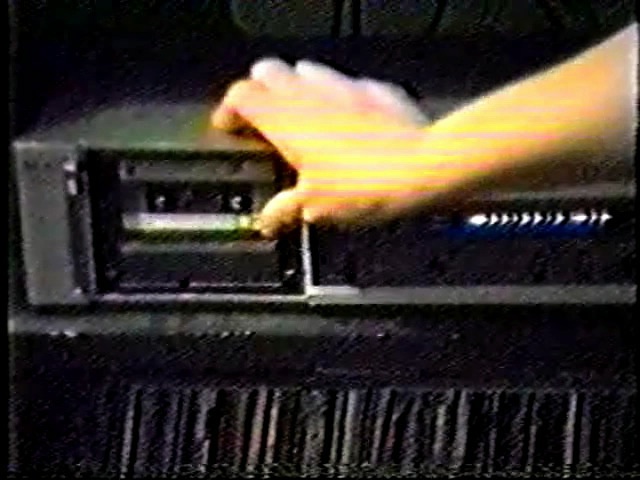
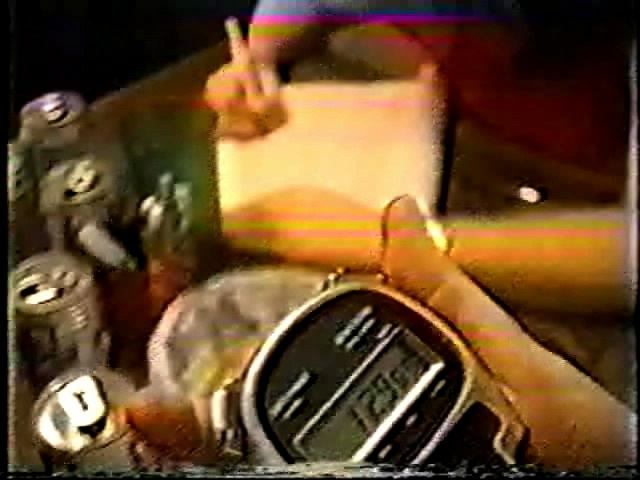
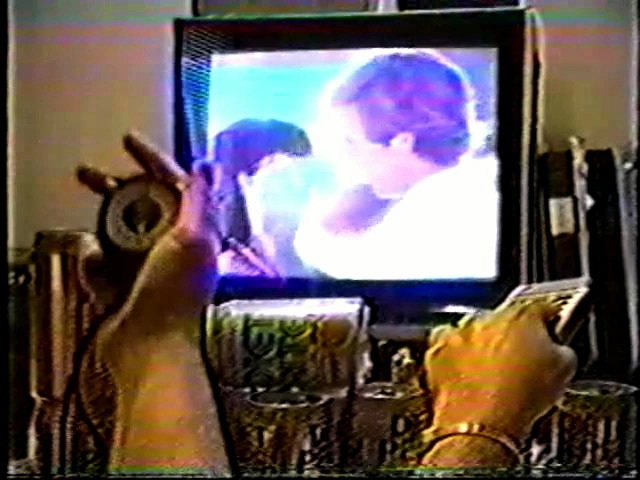

Figures 8–11. Images from Sterling Eidolan and the Odd Woman Out's fan vid, "Pressure" (1990), showing the vidders creating a vid.
[4.5] VCR vidding requires a lot of planning, measuring, and mathematics to compensate for the imprecision of the technology. VCR vidders are bricoleurs, repurposing equipment that was never meant to be used for filmmaking. In "Pressure," the vidders use stopwatches and calculators to plan their vid on paper. They then build the vid to the specs of their agreed-upon blueprint. The Quantum Leap vid that Sterling Eidolan and the Odd Woman Out make within "Pressure" isn't actually put together until the end, where we see a long line of video cassettes, all cued up, with the selected clips ready to be laid down, in order. Among the last of the shots the vidders give us is one of snaking audio cables, plugged into the VCR (figures 12–15).
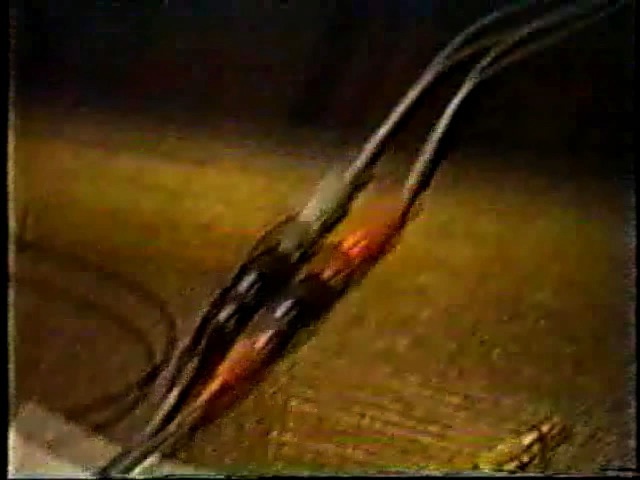
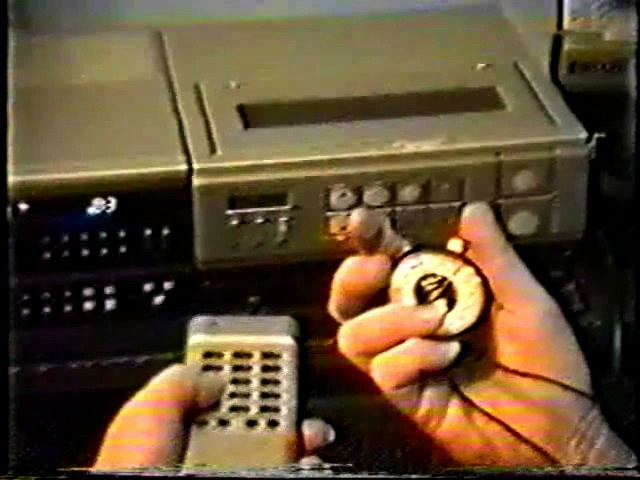
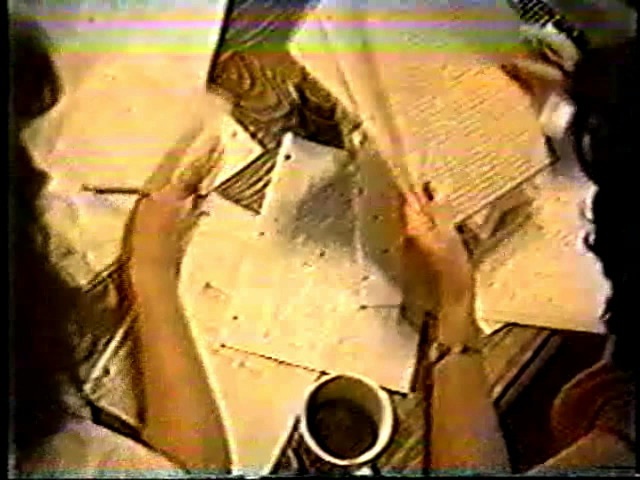
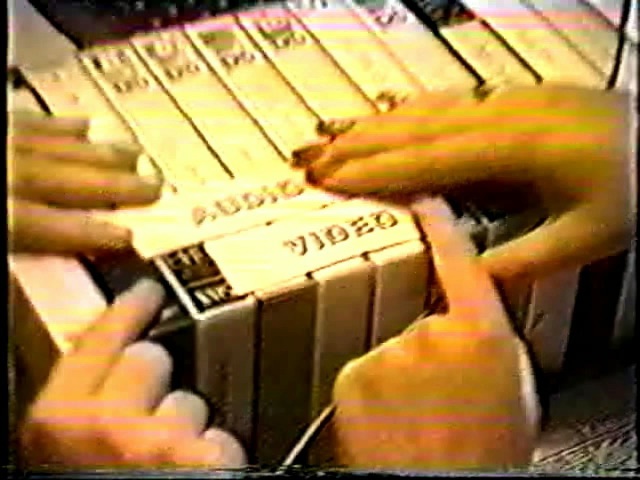
Figures 12–15. Images from Sterling Eidolan and the Odd Woman Out's fan vid, "Pressure" (1990), showing the technological requirements of vid making.
[4.6] If they've miscalculated on their timing, on the rollback, on anything, their clips will not be synchronized with the music, and the vid will fail. This is the vid's narrative climax—talk about pressure!
[4.7] If "man versus technology" is a clichéd theme, the story of woman versus technology is less well plumbed. "Pressure" makes it clear that tales of "vidding uphill, in the snow, both ways" are not hyperbole: these women filmmakers are actually making art with jerry-rigged equipment. But "Pressure" also tells a story of female teamwork and creativity, and the vidders take pains to explicitly foreground their collaboration, shooting footage that demonstrates them actively thinking and working together.
[4.8] In particular, we are given many scenes of the vidders in front of the television, though this is not a typical picture of women watching television. Instead, they watch on fast-forward, stopwatches in hand, evaluating and measuring what they see. Both as filmmakers and as the stars of "Pressure," Sterling Eidolan and the Odd Woman Out are careful to perform both their judgment of footage and their process of negotiation and decision making. In one notable sequence, one vidder gives an avid thumbs-up to signal her approval of the clip on screen—a steamy kiss—while her partner seesaws her hand: she is not sold. At other points in the vid, we see the vidders performing their joint frustration or agreement by giving thumbs up or thumbs down to particular filmmaking decisions (figure 16).

Figure 16. Image from Sterling Eidolan and the Odd Woman Out's fan vid, "Pressure" (1990), showing the vidders making decisions about clips.
[4.9] But the vid stages not only the vidders' rational artistic judgment but also their pleasures and pains: the women eat, drink, laugh, get frustrated, doze off, collapse. At one memorable point, they stage their own visceral enjoyment of a love scene they're watching on screen. The vidders are explicitly framed for us both as judging, rational artists and as physical, desiring bodies enjoying themselves in community. This is not a stereotypical representation of women. "Pressure" depicts women working, thinking, judging, eating, and enjoying television together; they are also making art in the domestic sphere, among stacks of VHS cassettes and piles of fan fiction zines. There is a wholeness to their representation that evokes the hypothetical protagonists Virginia Woolf imagined in A Room of One's Own (1929): Chloe and Olivia, who work in a laboratory together and like each other. They are bodies and minds both, fully rounded women. The vidders have successfully reunited the desiring body and the analytical voice.
[4.10] Like Kandy Fong's "Both Sides Now," "Pressure" demonstrates that desiring subjectivity can coexist in the same body as the ability to make precise measurements. Whereas Fong's slide show evokes gender (and other) complexities in the multitude that is Spock, Sterling Eidolan and the Odd Woman Out do something rarer: they create their own complex self-representations. The primary vidder in the three-person team of Sterling Eidolan and the Odd Woman Out had studied film and was able to shoot live-action footage, but "Pressure" was made by the same process being documented within the vid: it was shot on video and edited together with stopwatches and VCRs. Few women have historically had the training or the equipment to create their own footage; as a result, telling stories with extant footage has been a way to surmount the bar that hinders women's entry into the expensive and traditionally male-dominated film world. As Abigail Derecho (July 26, 2007, Weblog conversation with Christian McCrea, http://www.henryjenkins.org/2007/07/gender_and_fan_culture_round_e.html) notes, although DIY and other forms of remix culture are now broadly popular, early remix genres have their origins in minority discourse; she argues that this creativity was a response to restriction and scarcity among women and blacks. It is also worth noting that editing was also one of the few historically female jobs in filmmaking, seen to be related to sewing (Ondaatje 2002), so it is perhaps unsurprising that vidding, an art form that happens entirely in the editing room, should be dominated by women.
[4.11] The live-action footage of "Pressure" is a rarity; most vids articulate their arguments by editing and remixing extant footage. It is worth examining one of Sterling Eidolan and the Odd Woman Out's more traditional songvids to see what they typically made with their stopwatches, calculators, and home recording equipment. "Oh, Boy!" (ca. 1990) is a Quantum Leap vid that takes advantage of the fact that protagonist Sam Beckett's eponymous catchword also happens to be a famous Buddy Holly song. Beckett, who time travels by leaping into other people's bodies, temporarily taking on their lives and their problems, greets every surprising development with "Oh, boy!" Sterling Eidolan and the Odd Woman Out take on the daunting task of synchronizing those utterances to Holly's sung vocal, and they succeed to a startling degree. The difficulty of doing that level of synchronization with two VCRs really has to be attempted to be appreciated. (Watch, too, the blonde woman shimmying in perfect time to the cymbal crashes between seconds :15 and :17.)
Clip 3. Excerpt from Sterling Eidolan and the Odd Woman Out's fan vid, "Oh, Boy!" (ca. 1990).
[4.12] But "Oh, Boy!" is not merely a technical masterpiece. It also fulfills a critical/analytical function. Sterling Eidolan and the Odd Woman Out are not interested in all the moments wherein Sam Beckett shows surprise. Rather, they seem particularly interested in collecting and commenting on his encounters with women. Although Beckett occasionally leaps into a female body, most plotlines feature Beckett leaping into, and therefore taking on, the problems of a male (and presumptively heterosexual) protagonist. Consequently, the show's weekly plotline tends to feature some sort of female love interest—but because Beckett is not in his own body, he is always in the odd position of being sexually mistaken for someone else: "Oh, boy!" As a result, Beckett is often portrayed as playing sexual defense, fending off the advances of women who, quite reasonably, mistake him for their boyfriends, lovers, and husbands.
[4.13] The vidders establish their critical interest in this erotic dynamic by opening with an extended scene, complete with original audio track, from the episode "Honeymoon Express" (1989). When he leaps, Beckett finds himself on a train to Niagara Falls with "his" newlywed—and sexually aggressive—wife, Diane. When Beckett tries to tell her he's not really her husband but actually a time-traveling physicist, Diane takes it as an invitation to sexual role-play (figure 17): "Oh, I like it. And I'm 'Lara,' the KGB's sexiest agent. I boarded the Orient Express with orders to seduce Sam Beckett, America's most famous astrophysicist…and have him fall madly in love with me and drive him crazy by refusing to sleep with him until he tells me how to make a hydrogen bomb. Tell me your fantasy."
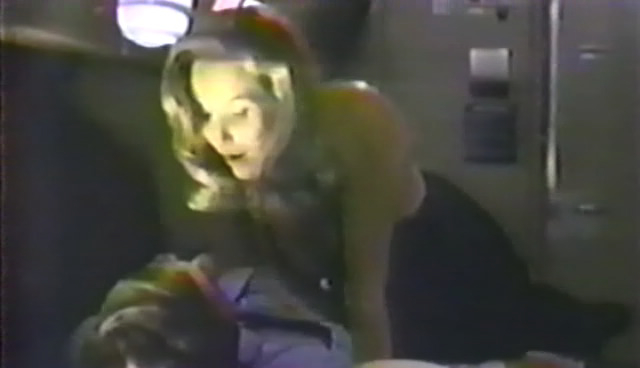
Figure 17. A sexually aggressive Diana mistakes Beckett for her groom in Sterling Eidolan and the Odd Woman Out's fan vid, "Oh, Boy!" (ca. 1990), in a clip from a Quantum Leap episode, "Honeymoon Express" (1989).
[4.14] Beckett's response to this, of course: "Oh, boy…" Beckett spends the entire sequence on his back, staring up dazedly at the seductive Diane, who is stroking his chest and kissing him. Visually, Diane is on top for the entire sequence, which then leads into the vid proper, in which Sam is fondled, hugged, kissed, grabbed, and otherwise womanhandled. As in "Closer" and "Both Sides Now," Sterling Eidolan and the Odd Woman Out use the audio as an interpretive lens, essentially splitting the song's lyric phrases so that the expressions of sexual desire correlate with the shots of women, while "Oh, boy!" is turned into Beckett's gulp of a response. The women in the vid are constructed as desiring subjects with Sam Beckett as their object, and Buddy Holly's sexually confident, boastful subject position—"All of my love, all of my kissin'/You don't know what you've been a-missin'"—is given to the women on screen. This kind of audiovisual transsexuality is particularly appropriate for a show like Quantum Leap, which is already, at least in part, about body swapping and various other forms of role-play, although Quantum Leap never fully explored the more subversive implications of its premise.
[4.15] "Oh, Boy!" also critically reworks another potentially negative feature of much mainstream television: what fans call the "Bimbo of the Week" phenomenon. Beckett, like most male television protagonists in this sort of show, gets to engage a new, narratively disposable woman each week. By editing years' worth of women into a single vid, the vidders alter the show's male-to-female ratio, swamping the male protagonist. The lyric is telling: You don't know what you've been a-missin'. What television is missing is women, plural; most television shows still give us a variety of male characters and "the girl." But here, these individual women from different episodes come to be seen as related, to share a common language and experience. Sterling Eidolan and the Odd Woman Out have also found a way, through editing, to depict the female audience of which they themselves are a part, creating representations of women not just as individuals (and worse, as individuals defined almost entirely as love interests) but as a desiring female collective, a community.
5. Conclusion
[5.1] Vidding is a form of collaborative critical thinking. While vidders make an infinite variety of arguments about the television shows and films they love—theorizing about characters, fleshing out relationships, emphasizing homoerotics, picking apart nuances of plot and theme—these arguments frequently articulate alternative perspectives, particularly in terms of gender and sexuality. Although there are as many different reasons to vid as there are vidders, and as many individual arguments as there are vids, vidding continues to be female dominated, and a high percentage of vids are still engaged in fleshing out marginalized female perspectives (note 6). Male/male slash vids, which are an expression and articulation of female sexuality both straight and queer, continue to be a significant and popular subgroup of vids (note 7), but we have seen more of what is called femslash or femmeslash, expressing overtly lesbian perspectives and desires (note 8). More recently, many in the vidding community have been talking about how better to engage the marginalized perspectives of characters of color, particularly female characters of color (note 9), and there is also a strong canon of metavids about vidding and the female fan community itself (note 10).
[5.2] All of these vids work to heal wounds created by the marginalization, displacement, and fragmentation of female characters like Star Trek's Number One, restoring female subjectivity and community by editing together what was put asunder. To be a vidder is to work to reunite the disembodied voice and the desiring body, and to embark on this project is to be part of a distinctive and important tradition of female art.
